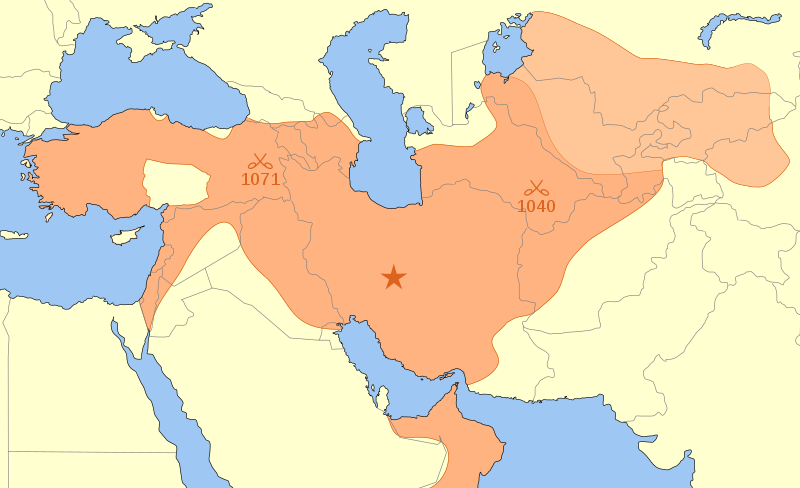ფაილი:Seljuk Empire locator map.svg

ათე SVG ფაილიშ PNG გიწოთოლორაფაშ ზჷმა რე: 800 × 488 პიქსელი. შხვა გოფართაფა: 320 × 195 პიქსელი | 640 × 390 პიქსელი | 1,024 × 625 პიქსელი | 1,280 × 781 პიქსელი | 2,560 × 1,562 პიქსელი.
ორიგინალი ფაილი (SVG ფაილი, ნომინალურო 800 × 488 პიქსელი, ფაილიშ ზჷმა: 161 კბ)
ფაილიშ ისტორია
ქიგუნჭირით რიცხვის/ბორჯის თიშო, ნამჷ-და ქოძირათ ფაილი თი რედაქციათ, ნამუ რედაქციას თი რიცხვის/ბორჯის რდუნ.
| რიცხუ/ბორჯი | ჭკუდი | გონზჷმილაფეფი | მახვარებუ | კომენტარი | |
|---|---|---|---|---|---|
| მიმალი | 17:24, 5 მანგი 2014 |  | 800 × 488 (161 კბ) | Ras67 | frame removed |
| 01:28, 31 მარაშინათუთა 2009 |  | 642 × 396 (204 კბ) | Dipa 1965 | Neither Aegean islands nor Cyprus belonged to Seljuk territory | |
| 08:26, 12 მელახი 2008 |  | 642 × 396 (201 კბ) | MapMaster | + two battle locations | |
| 06:32, 11 მელახი 2008 |  | 642 × 396 (197 კბ) | MapMaster | an attempt to fix problem w/gallery | |
| 05:57, 11 მელახი 2008 |  | 642 × 393 (197 კბ) | MapMaster | Removed BMP artifact | |
| 05:49, 11 მელახი 2008 |  | 642 × 393 (198 კბ) | MapMaster | {{Information |Description=A map showing the w:en:Great Seljuk Empire\Great Seljuk Empire at its height, upon the death of w:en:Malik Shah in 1092. |Source=self-made |Date=10 March 2008 |Author= MapMaster |Permission= |other_ver |
ფაილიშ გჷმორინაფა
გეჸვენჯი ხასჷლა გჷმირინუანს თე ფაილს:
ფაილიშ გლობალური გჷმორინაფა
თე ფაილი გჷმირინუაფუ გეჸვენჯი ვიკეფს:
- af.wikipedia.org-ს გჷმორინაფა
- als.wikipedia.org-ს გჷმორინაფა
- ar.wikipedia.org-ს გჷმორინაფა
- الدولة السلجوقية
- غوريون
- سلاجقة العراق
- فخر الدين الرازي
- الإسلام في تركستان الشرقية
- تاريخ إيران
- جلال الدولة ملك شاه
- بوابة:الإمبراطورية الروسية
- بوابة:الإمبراطورية الروسية/بوابات شقيقة
- النزاعات في آسيا
- بوابة:الإمبراطورية الألمانية
- بوابة:الإمبراطورية الألمانية/بوابات شقيقة
- بوابة:إمبراطورية اليابان
- بوابة:إمبراطورية اليابان/بوابات شقيقة
- بوابة:الخلافة الراشدة
- بوابة:الدولة الأموية
- الحروب السلجوقية البيزنطية
- بوابة:الإمبراطورية الفرنسية الأولى/بوابات شقيقة
- بوابة:الإمبراطورية الفرنسية الأولى
- بوابة:الإمبراطورية النمساوية/بوابات شقيقة
- بوابة:الإمبراطورية النمساوية
- بوابة:الإمبراطورية البريطانية
- بوابة:الإمبراطورية البريطانية/بوابات شقيقة
- بوابة:الإمبراطورية الفرنسية الثانية
- بوابة:الإمبراطورية الفرنسية الثانية/بوابات شقيقة
- بوابة:الإمبراطورية البرتغالية
- بوابة:الإمبراطورية البرتغالية/بوابات شقيقة
- بوابة:الإمبراطورية النمساوية المجرية
- بوابة:الإمبراطورية النمساوية المجرية/بوابات شقيقة
- بوابة:الإمبراطورية المغولية
- بوابة:الإمبراطورية المغولية/بوابات شقيقة
- بوابة:الإمبراطورية الإسبانية
- بوابة:إمبراطوريات
- بوابة:إمبراطوريات/بوابات شقيقة
- بوابة:الإمبراطورية الإسبانية/بوابات شقيقة
- بوابة:العصور الوسطى/مقالة مختارة
- بوابة:العصور الوسطى/مقالة مختارة/15
- بوابة:الدولة الأموية/بوابات شقيقة
- بوابة:الخلافة الراشدة/بوابات شقيقة
- بوابة:مملكة فرنسا
- بوابة:مملكة فرنسا/بوابات شقيقة
- بوابة:الإمبراطورية الرومانية المقدسة
- بوابة:الإمبراطورية الرومانية المقدسة/بوابات شقيقة
- قالب:بوابات الإمبراطوريات
- طغان شاه
- أرسلان أرغون
- أرسلان شاه (سلاجقة العراق)
- مؤيد الملك
ქოძირით, თე ფაილიშ გლობალური გიმორინაფა.


